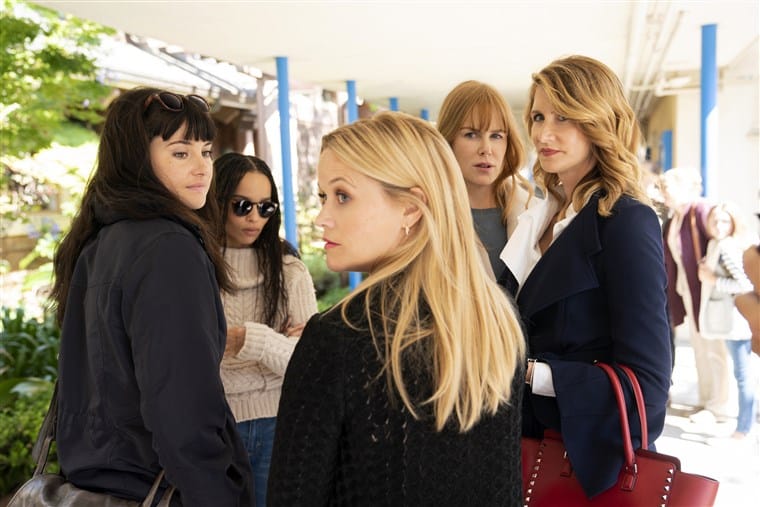In Big Little Lies, a sense of privacy is elusive, if not nonexistent. In the picturesque, privileged beachside town of Monterey, the women entangled in these lies have little to no semblance of a barricade between themselves and the gossip of the community. Their intimate lives and secrets, even behind closed doors, play out in such a voyeuristic manner that the wall-to-wall windows of each of their houses act as a menagerie keeping the images out in the open with the noise on mute. And all the while, the audience bears witness as the pain of past and present is inflicted upon these women. If there is one element that Big Little Lies uses to tie the audience and its characters together, it’s the shared experience of trauma.
When the announcement was made that production of a second season would begin for HBO’s resplendently rich series, there was a tremor of shock felt through the industry and audiences. The first season was practically perfect, receiving wide acclaim and earning several awards. Judged as a limited series by the Television Academy and the Hollywood Foreign Press Association, among others, the season two announcement was met with a jolt of excitement, frustration, and some apprehension. As an ardent fan of the first season, I fell under apprehension. Not due to concern for handling the next phase of the Monterey Five’s story, but the show’s continued confrontation with abuse, rape, gaslighting, and trauma.
I, along with millions of others, went into a frenzy – a glass of white wine in hand – watching the intertwining and connecting narratives of these dynamic women play out. I had no existing relationship to the source material, the novel of the same name by Liane Moriarty. But with powerhouses like Reese Witherspoon, Nicole Kidman, Zoë Kravitz, Shailene Woodley, and Laura Dern at the helm, there was little to nothing swaying my dedicated viewership.
Following five women as their lives and the lives of their children are intertwined in matters of abuse, bullying, and lies, the sleek series harbored intense commentary. Our investment in the show with each passing episode began to feel more cathartic; the emotional reactions came from a guttural place. Interest didn’t lie so much in the question of who died by the end of the series — that mystery was only the tipping point — but what lead to this violent conclusion. In that first watch, I realized what was tying me to these women: trauma was the tie that would bind the characters and audiences’ relationship with the show.
Big Little Lies saw characters Jane, Madeline, Bonnie, Celeste, and Renata confronting one another and themselves. Jane still struggled with post-traumatic stress years after her rape while also facing the possibility that her son was a bully. Madeline became Jane’s confidant and champion, along with Celeste, who was a victim of domestic abuse at the hands of her husband. Renata Klein openly could not grapple with her daughter’s fear of her school bully. And in the end, Bonnie (misused in the first season), became the one to harbor the most guilt from the final blow. Leading into the second season of the series, what ties these women together was the shared trauma that they had experienced and the guilt and shame that befalls women who are survivors.
But there’s more than just the surface level of what these women endure. The relationship to and communication of trauma and abuse on Big Little Lies begins with the commonality between Celeste (Kidman) and Amabella’s (Ivy George) shared experiences. Not only are they connected through their trauma by the man and boy perpetrating the act but also in the means by which they carry themselves through their trauma. Concerned by the outcome – further pain at their abuser’s hands – the two characters remain silent. Continuing to suffer rather than face lines of questioning and pressure for proof, as seen with Amabella’s mother, Renata (Dern), their stoicism becomes preferential to public forms of torment, frustration, and doubt.
Each emotional touchstone felt like a mirrored event, not only between characters but replicating the similar peaks and valleys of real-life survivors. For one viewer in particular, situations inhabited by these characters translated to a confrontation of one’s survivalist, silent mentality – my own. The show premiered roughly a year and a half following my own maneuvering of abuse, and while I didn’t recognize it fully until three years after the fact, Big Little Lies served as an entry point into identifying what I had endured. Structured by broad strokes and intimate, nuanced moments, the silence of Celeste and Amabella and even the post-traumatic stresses suffered by Jane shown through their collective fear and shame began to point to my own internalized wounds and ask where they came from and how they got there.
The murder mystery aspect of Big Little Lies always served as a launching pad for the broad, universal themes the show sought to discuss. But dressed in the finest clothes with homes that had walls of glass, the voyeurism and discomfort became a revelatory tie-in to viewers, myself included. In its poignancy and trenchant maneuvering of replicating storylines and conveying shared emotions, these traumas became the empathetic touchpoint that leads to the release of the season one finale.
But just as it will be captured in the upcoming second season, when our abusers die or fade into obscurity in the peripheries of our lives, the trauma doesn’t die or leave with them like weighted baggage. Still, we tell ourselves it does end in their passing until something like Big Little Lies comes along and reminds us of the wounds internal and external that are still scabbing and need to breathe in order to to heal, culminating in the big, little lies we tell ourselves just to get by.

